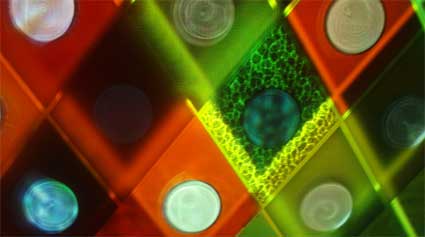Jens Hauser’s presentation in Aix en Provence (part 1)
On Wednesday afternoon, last week, curator Jens Hauser gave us the low-down on the upcoming SK-INTERFACES exhibition which will take place on 1st Feb – 30th March in the framework of Liverpool 2008 European Capital of Culture.
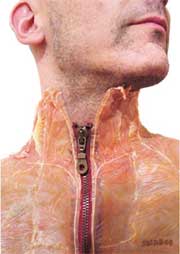
A skin jacket by Olivier Goulet whose work will be part of SK-INTERFACES
The event will demonstrates how artists today are artists using skin, materially or metaphorically, as an interface, and going beyond the descriptive surface of the skin, to explore issues of xeno-transplants, trans-species and trans-racial exchanges.
After an era of de-materialization (“everything digital”), contemporary art is showing a tendency of phenomenological re-materialization, a re-integration of corporality. Besides, instead of representing objects, graphic depictions or simulations, the art is gearing towards transformational processes with performance characteristics. Lastly, as the creation of the new Hybrid Art Category at ars electronica this year demonstrated, the existing categories are not sufficient anymore to represent the current state of technology-based art.
SK-INTERFACES is not about interfaces as we know them, nor is it about art on the skin. Instead, the exhibition aims to raise questions such as: What happens when we abolish surfaces? The cosmetic industry represent the skin as something which has only 2 dimensions, it is a surface for inscription. What is the third dimension hidden beneath the smooth surface? What does the interface become, if we leave behind the traditional man-machine mechanisms?
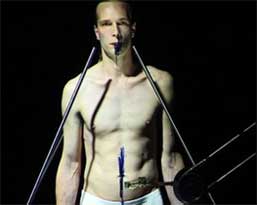
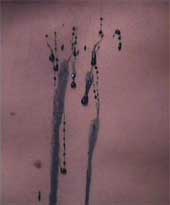
Hauser showed us a fascinating 5 minute video of a performance where dancer Yann Marussich uses his body as an interface. Bleu Provisoire performance takes the audience to a journey through the skin, which the spectators traverse with their eyes. The dancer remains motionless, like a sculpture, during one hour. The dance is made by blue secretions which gradually come out of the artist’s body as he sweats. The blue is used here to deviate from the idea of the red blood linked to man.
Science and new technologies have modified the way we perceive the skin. Examples:
The Victimless Leather Jacket,
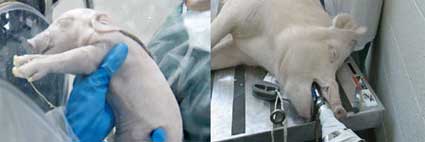 Image from Organ Farm
Image from Organ Farm
Xenotransplantation
There are a few examples of patients who needed liver transplants and were able to use pig livers as “bridges” to hold them over until human transplants were found (porcine liver perfusion). The liver of the patient was kept outside the body in a plastic bag and hooked up to the main liver arteries. In a case like this one, the skin doesn’t fulfill its traditional role of barrier between the inside and the outside.
Stelarc‘s Suspension performances (which involved having his naked body carried around suspended in the air by inserting fishhooks into his skin) also go beyond the idea of skin as a surface. His performances materialize two fantasies: the masochist phantasm of having one’s body skinned and the one of having one’s body duplicated. In Suspension, the body is not limited to the skin anymore.

Two works by Irish performanace artist Kira O’Reilly emerged after a residency at Symbiotica inthewrongplaceness.
She worked with newly dead pigs used for medical research. After the scientists had put the pig to into a non-recoverable anaesthetic and had taken the animal’s lungs, she took a biopsy of the pig’s skin from which to cultivate skin cells in vitro, in preparation to work from a biopsy of her own body’s skin (more in Leonardo Electronic Almanach).
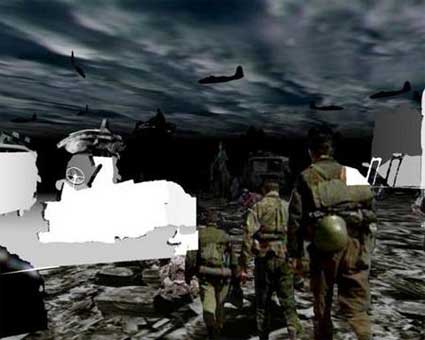
Some of the works which will be part of SK-INTERFACES:
– Maurice Benayoun‘s 1997 installation World Skin. The piece while based on digital technology, searches to grab some materiality. Equipped with cameras visitors are invited to become a tourist in the Land of War. They move through a 3D space made of photographs and news images which presents a universe imbued by mute violence. When they «shoot» a snapshots, visitors can see that the topics are extracted from the universe of the installation. Visitors may take home the prints of their «Safari».
– Wim Delvoye‘s video Sybille II. The magic of the work lies in the use of extreme close-ups which turns the surface of the skin into a 3D landscape. That video is probably the most disturbing work i’ve seen in a long time.
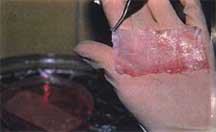
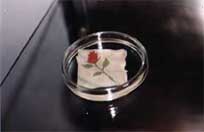 Culture de Peaux d”artistes/see also Skin Culture
Culture de Peaux d”artistes/see also Skin Culture
– Art oriente Objet (interview) will also be showing some pieces in Liverpool.
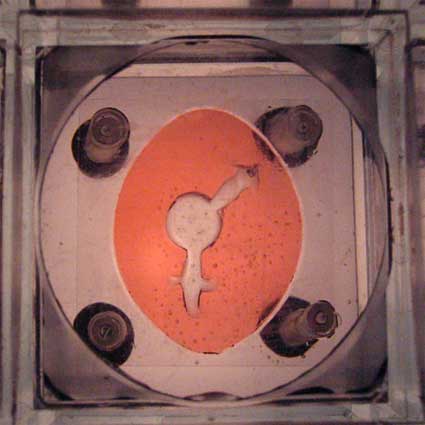 Polyacrylamide gel prototype of hymen construct with unisex cut-out
Polyacrylamide gel prototype of hymen construct with unisex cut-out
– Julia Reodica‘s hymNext Designer Hymen Project, unisex hymens sculpted with living materials and the artist’s body cells into a variety of designs for the application upon the human body (Adam Zaretsky my favourite “bioart punk” had it installed on one of his nostrils).
– Neal White will show a new piece.
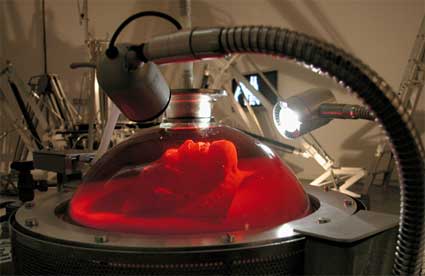 Photo credit: Tim Wetherell & Stelarc
Photo credit: Tim Wetherell & Stelarc
More skin-related works highlighted during the talk:
Stelarc’s Partial Head, a work which plays on the idea of confusing the surface and the interface. The artist’s face was scanned then digitally transplanted over a hominid skull, constructing a Third Face, one that becomes post-hominid and pre-human in form, referring to the theory of evolution but going backwards. The data was used to print a scaffold of ABSi thermal plastic, using a 3D printer. The scaffold was seeded with living cells. The life-support system of the partially living portrait was a custom engineered bioreactor/incubator and circulatory system which immersed the head in nutrient kept at 37 C. The Partial Head became contaminated after one week.
Since 2003, French artist Orlan is working on The Harlequin Coat, an organic patchwork created with skin cells cultivated in vitro, taken from the artist and from people with various skin colour and origin. When the artist ordered the cells online, she realized that the racial category is still in use in databanks, although the cells are the same as epidermis do not contain the melatonin (the hormone that affects skin pigmentation). This prototype of a biotechnological coat, consisting of in vitro skins in petri dishes, symbolise cultural crossbreeding and hybridization. Harlequin Coat seeks to raise various questions: “Can skins of different colours be cultivated? What kind of information can be obtained from the donors? Can a person still be the owner of his or her cells? Does self-ownership continue to exist at the fragmented level? How are such issues perceived in various countries, and especially in the context of a non-western viewpoint?�
Zane Berzina‘s Touch Me Wallpaper printed with thermochromic ink, so its colors lighten with heat — via a hand or a radiator.
Zbigniew Oksiuta‘s futuristic dwellings which act as living and autonomous bioreactors.
Melatonin Room, by Swiss architects Jean-Gilles Decosterd and Philippe Rahm.
The Telepresence Garment, conceived by Eduardo Kac to allow its wearer to be in the skin of someone else.
Some of the books Jens Hauser recommended: François Dagognet, La peau découverte; Christophe Dejours, Le corps entre biologie et psychanalyse; Didier Anzieu, Le Moi-peau.

